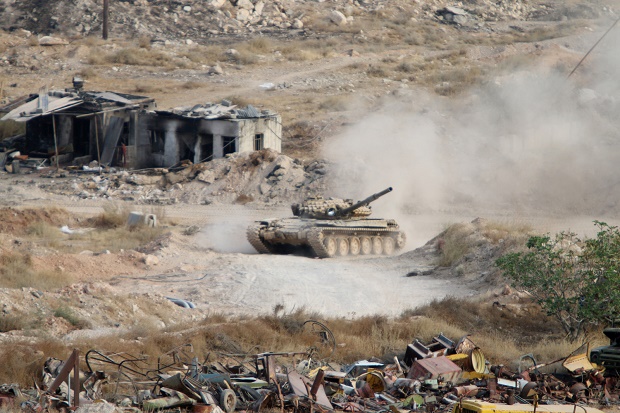Mustard gas used in Syria fighting—UN watchdog source

A Syrian tank fires in Harasta, northeast of Damascus, Syria, Thursday, Oct. 22, 2015. Komsomolskaya Pravda via AP
THE HAGUE, Netherlands—Weapons experts have concluded for the first time that mustard gas was used during fighting in Syria, UN sources told AFP Thursday adding a terrifying dimension to the four-year conflict.
READ: General: Russia sends anti-aircraft missiles to Syria
The deadly gas, first used in battle in World War I, was unleashed in the flashpoint town of Marea in the northern province of Aleppo on August 21, a source from the Organisation for the Prohibition of Chemical Weapons (OPCW) said.
At that point the moderate Syrian opposition, which has been fighting to oust Syrian President Bashar al-Assad, was battling against jihadist militants from the Islamic State of Iraq and Syria (ISIS) group.
“It is the first time that we have confirmed the use of mustard gas in Syria,” the source said, asking not to be named.
“We have determined the facts, but we have not determined who was responsible.”
READ: Russian strikes take toll among Syrian civilians
A confidential report has been sent to the 192 member states of the OPCW, which are due to meet for the UN body’s annual conference at the end of November at its headquarters in The Hague.
After the horrors of World War I, the use of mustard gas and other chemical weapons in warfare was banned in 1925. Its production and stockpiling was also then outlawed under the 1993 Chemical Weapons Convention.
But large quantities of mustard gas were used in the 1979-1988 Iraq-Iran war. Former Iraqi dictator Saddam Hussein also unleashed it on the Kurds in Halabja, in northern Iraq, in 1988.
‘Terrible smell, yellow gas’
Syrian rebels and aid groups had said in late August that dozens of people were affected by a chemical attack on Marea.
The town is a stronghold of the moderate opposition, which ISIS has been seeking to seize for months as part of its plan to capture large parts of Syria and neighbouring Iraq in its quest to establish an Islamic caliphate.
Doctors without Borders (MSF) said it had treated four civilians from one family, while militants spoke of a “terrible smell” after IS launched some 50 mortars on the town.
According to patients at an MSF hospital in Aleppo, a mortar hit their house and “after the explosion a yellow gas filled the living room.”
More than 25 civilians were affected, suffering from difficulty breathing as well as skin irritations.
First discovered in 1822, the choking gas causes painful blisters of the skin, eyes and respiratory tract. The OPCW has said it is easy to make.
Under a deal hammered out in 2013 between Russia and the United States following a sarin gas attack on the outskirts of Damascus in which hundreds died, the Syrian regime pledged to hand over all its toxic weapons to the OPCW for destruction.
Assad’s government had had stockpiles of more than 19 tonnes of mustard gas, but it handed them over as part of the multinational effort to strip the country of 1,300 metric tonnes of chemical weapons.
But according to the Wall Street Journal, the jihadist ISIS was able to buy some of the gas as the regime was disposing of it.
Allegations that ISIS has been using chemical arms have been mounting in recent months in both Iraq and Syria.
Reports emerged in August that ISIS jihadists in Iraq may have been using mustard gas against Iraqi Kurdish fighters.
A US official said it was “plausible” the extremist group had used the deadly gas on Kurdish peshmerga fighters.
The UN Security Council unanimously adopted a resolution in August setting up ajoint investigation to determine who was behind ongoing chemical weapons attacks in Syria, mainly from chlorine gas.
It was a rare display of unity over the war in which some 250,000 people have been killed, and almost 12 million displaced.
The panel will be fully up and running around mid-November, with offices in New York, The Hague and Damascus, and a first report on its findings expected in February.
The head of the panel, Virginia Gamba, told AFP this week: “Will I have the name, surname, and age of a perpetrator? I have no idea. It’s going to be very hard to do.”














